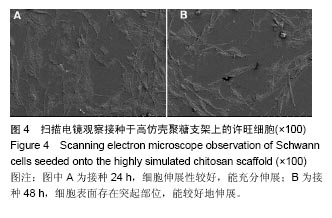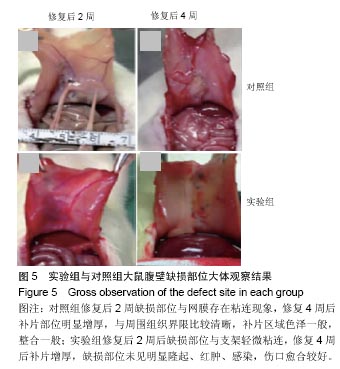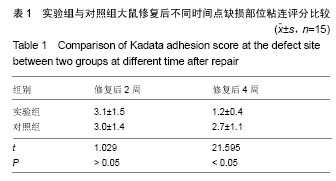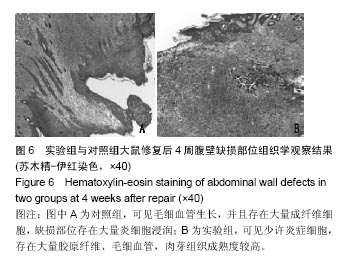| [1]段友良,林奥.复合补片和生物补片修复犬腹壁缺损的对比[J].中国组织工程研究,2016,20(12):1753-1758.[2]陈革,唐健雄,黄磊,等.生物补片在治疗感染和污染腹壁缺损方面的体会(附34例病例)[J].中华疝和腹壁外科杂志:电子版, 2011, 5(4):389-393.[3]Beres A,Christison-Lagay ER,Romao RL,et al.Evaluation of Surgisis for patch repair of abdominal wall defects in children. J Pediatr Surg.2012;7(5):917-919.[4]tani KM,Rosen M,Vargo D,et al.Prospective study of single-stage repair of contaminated hernias using a biologic porcine tissue matrix: the RICH Study.Surgery. 2012;152(3):498-50.[5]陈革,唐健雄,黄磊,等.感染和污染腹壁缺损的治疗体会(附36例报告)[J].临床外科杂志,2011,19(6):379-381.[6]Janfaza M,Martin M,Skinner R.A preliminary comparison study of two noncrosslinked biologic meshes used in complex ventral hernia repairs.World J Surg.2012,36(8):1760-1764.[7]Rosen MJ,Denoto G,Itani KM,et al.Evaluation of surgical outcomes of retro-rectus versus intraperitoneal reinforcement with bio-prosthetic mesh in the repair of contaminated ventral hernias.Hernia.2013;17(1):31-35.[8]Huang SP,Hsu CC,Chang SC,et al.Adipose-derived stem cells seeded on acellular dermal matrix grafts enhance wound healing in a murine model of a full-thickness defect.Ann Plast Surg.2012;69(6):656-662.[9]宋致成,顾岩.应用猪小肠黏膜下层与肌腱细胞构建组织工程支架修复成年雄性普通犬腹壁缺损的实验研究[J].外科理论与实践,2012,17(3):270-274.[10]曾逃方,罗旭,辛国华,等.激光微孔化猪脱细胞真皮基质的设计、制备及同步移植实验[J].上海交通大学学报(医学版), 2012, 32(10):1307-1311.[11]刘昶,李金松,纪艳超.生物补片在疝外科的应用及相关研究进展[J].中华疝和腹壁外科杂志:电子版,2013,7(2):109-112.[12]ten Broek RP,Stommel MW,Strik C,et al.Benefits and harms of adhesion barriers for abdominal surgery: a systematic review and meta-analysis.Lancet.2014;383(9911):48-59.[13]Yigitler C,Karakas DO,Kucukodaci Z.Adhesionpreventing properties of 4% icodextrin and canola oil: a comparative experi-mental study.Clinics.2012;67(11):1303-1308.[14]Catena F,Ansaloni L,Di SS,et al.P.O.P.A.study: prevention of postoperative abdominal adhesions by icodextrin 4% solution after laparotomy for adhesive small bowel obstruction. A prospective randomized controlled trial.J Gastrointest Surg. 2012;16(2): 382-388.[15]贺丰,俞兴,穆晓红,等.新型脊髓完全横断缺损模型大鼠的建立[J].中国组织工程研究, 2016,20(5):635-639.[16]段友良,林奥, DuanYou-liang,等.复合补片和生物补片修复犬腹壁缺损的对比[J].中国组织工程研究,2016,20(12):1753-1758.[17]匡毅,蒋又新,李福沛,等.带蒂背阔肌肌皮瓣修复腹壁巨大缺损的临床疗效分析[J].第三军医大学学报,2013,35(15):1643-1645[18]廖秀媚.米非司酮联合手术治疗剖宫产术后腹壁切口子宫内膜异位症的疗效分析[J].中国当代医药,2013,20(8):54-55.[19]邓姗,冷金花,郎景和,等.腹壁子宫内膜异位症术前预测补片的可行性分析[J].国际妇产科学杂志,2013,40(4):364-368.[20]陈艳军,高旭珍,张艳杰,等.高山红景天对肝纤维化成年雄性普通犬Smad3mRNA 表达的影响[J].医学研究生学报, 2012,25(12): 1242-1246.[21]Li L,Wang N,Jin X.Biodegradable and injectable in situ crosslinking chitosan-hyaluronic acid based hydrogels for postoperative adhesion prevention.Biomaterials. 2014;35(12): 3903-3917.[22]麻涛,田文,费阳,等.载有纳米银新型复合补片在污染条件下大鼠腹壁缺损修补中的运用[J].中华疝和腹壁外科杂志:电子版, 2015,9(6):459-462.[23]Bernabei M,Margaryan R,Arcieri L,et al.Aortic arch reconstruction in newborns with an autologous pericardial patch:contemporary results.Interact Cardiovasc Thorac Surg.2013;16(3): 282-285.[24]Schaefer M,Kaiser A,Stehr M,et al.Bladder augmentation with small intestinal submucosa leads to unsatisfactory long-term results.J Pediatr Urol.2013;9(6 Pt A): 878-883.[25]Kim HJ,Park SS,Oh SY,et al. Effect ofacellular dermal matrix as a delivery carrier of adipose-derivedmesenchymal stem cells on bone regeneration.J Biomed Mater Res B Appl Biomater.2012;100(6):1645-1653.[26]梁析,汤睿,冯学艺,等.比较小肠黏膜下层基质放置在腹壁不同层次的转归[J].中华疝和腹壁外科杂志:电子版,2016,10(4):255-260.[27]张荣,吴氢凯,罗来敏.丝蛋白涂层轻质聚丙烯网片对兔腹壁疝模型组织学反应的影响[J].国际妇产科学杂志,2012,39(3):281-283.[28]]Bellows CF,Smith A,Malsbury J,et al.Repair of incisional hernias with biological prosthesis: a systematic review of current evidence.Am J Surg.2013;205(1): 85-101. |
.jpg)





.jpg)
.jpg)
.jpg)